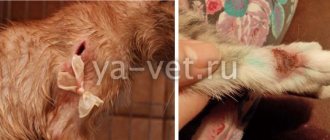Any disturbances in the functioning of the animal’s body immediately affect the general condition of the skin and coat. Often, with diseases of the digestive system or other organs, the skin begins to peel, dulls and hair falls out. Ear sores in cats can develop due to a lack of vitamins or minerals in the diet, as well as a decrease in the body's defenses.
In addition, the cause of the development of sores on the face and ears can be infectious or parasitic diseases. Only a qualified veterinarian has the right to determine the exact cause and prescribe appropriate assistance.
At home, trying to help a cat on your own is almost useless, as it may not give results. In addition, advanced infectious bacterial diseases cause serious complications.
Treatment of superficial wounds in cats
Most often in everyday life, cats, for one reason or another, receive shallow skin wounds, which their owners can easily handle on their own at home. First of all, an animal that has been injured should be calmed down by being picked up and made to feel completely safe. Only after this is it possible to further treat the cat’s wound.
So, how can you treat a cat’s wound? This question worries many pet owners, especially if they are faced with a similar problem for the first time. Treatment of superficial skin lesions in cats should begin with high-quality washing of the wound surface with disinfectants or bactericidal agents. This is necessary to prevent the development of an inflammatory process in the wound with subsequent suppuration. For reliable disinfection, it is better to use a hydrogen peroxide solution or a chlorhexidine solution, which are usually found in any home medicine cabinet.
When deciding how to treat a cat’s wound at home, you should remember Levomekol ointment. This product for external use not only has an excellent bactericidal effect, but also has an analgesic effect, and also helps to accelerate the regenerative processes of the skin and its rapid healing. It is important to remember that before treating wounds on pets, it is necessary to remove all hair from the skin surfaces in the area of damage, and after applying disinfectants, carefully apply a gauze bandage or bandage the wound if it is on the paw.
Symptoms: how to recognize the disease?
Necrosis of internal organs in a cat develops mainly against the background of other diseases, so signs of the underlying disease are observed. The presence of tissue death is indicated by the following symptoms:
- stool disorder;
- increased blood pressure;
- heart rhythm disturbance;
- refusal to eat;
- periodic increase in temperature;
- difficulty breathing or shortness of breath;
- lethargy, weakness.
On the external parts of the body the symptoms are pronounced:
- local increase or decrease in temperature;
- bluishness or redness, and eventually blackening of the skin;
- sweetish-putrid smell;
- decreased or absent sensitivity;
- hair loss in the affected areas;;
- persistent swelling, ulcers;
- hyperthermia;
- weakness, deterioration of health;
- pain, swelling and limited mobility if the bone is affected.
Return to contents
How to treat deep wounds in a cat?
Deep and open wounds in cats should be treated by a veterinarian. As a rule, such a laceration in a cat occurs as a result of a fight with dogs, and therefore often requires surgical suturing in a veterinary office or clinic. Naturally, before visiting a specialist, the damaged surface should be treated with an antiseptic to avoid infection of the soft tissues. After surgical suturing of the edges of the wound, the specialist must prescribe outpatient treatment to the animal using external agents that promote the healing of damaged skin and prevent infectious agents from penetrating into its deeper layers.
Diagnostics
No treatment can begin without diagnostic measures.
Self-medication without a preliminary diagnosis often provokes the development of complications and serious damage to the skin. Veterinary specialists often encounter pyoderma developing on the face and ears of cats due to the lack of timely and adequate treatment.
If you notice itching and the formation of crusts on your pet's ear, it is recommended to contact a veterinary clinic. In a clinical setting, the doctor conducts a clinical examination and collects anamnesis. The necessary studies are prescribed:
- general blood analysis;
- blood biochemistry;
- scraping from the affected area of skin;
- otoscopy;
- serological tests (if allergies are suspected).
Scraping from the affected areas of the skin is mandatory for carrying out bacteriological cultures on nutritious soils. This allows you to identify the pathogen and select a sensitive antibiotic. Advanced cases of damage to the auricle will include radiography, based on the results of which it is possible to diagnose the accumulation of exudate in the ear and the onset of degenerative processes of bone structures.
Treatment of purulent wounds
Treatment of purulent wounds in cats is a complex and labor-intensive process that pursues several goals at once: eliminating the source of inflammation, preventing the spread of infection to neighboring tissues or its entry into the blood, as well as high-quality care for your pet, which will allow it to quickly cope with the disease. It is better to entrust the entire process of treating an infected wound in an animal to an experienced veterinarian, who, before treating a purulent wound in a cat, will assess the extent of the spread of inflammation and make the only right decision regarding further tactics and the choice of treatment method.
As a rule, when wounds in cats suppurate, a specialist prescribes general injectable antibiotics to the animal. Additionally, the wound surface should be treated with an antiseptic solution several times a day, followed by applying ointments to the wound surface that draw out pus and promote healing of damaged skin surfaces. In some cases, when the infection cannot be stopped by conservative methods, the animal owner is offered surgical excision of the infected tissue or amputation of the pet’s limb damaged by the pathological process.
Why does necrosis occur?
The pathology is characterized by irreversible tissue death and cessation of cell activity due to impaired blood circulation, nerve conduction, and the activity of anaerobic or pyogenic bacteria. Most often, areas of the body where the blood vessels are small are affected - ears, paws, muzzle, tail, tongue. Often internal organs are affected - intestines, stomach, kidneys, liver. Depending on the location, the causes of necrosis are as follows:
- Internal organs: entry of foreign objects into the gastrointestinal tract;
- helminthiases;
- cirrhosis;
- volvulus.
- frostbite;
- glossitis (inflammation of the tongue);
Allergies or exposure to toxic chemicals can lead to tissue death.
In addition, the following factors cause tissue death in any area:
- autoimmune failure;
- allergy;
- prolonged inhalation of pesticides by animals;
- heart attack;
- electrical injury;
- disturbance of nerve conduction.
Return to contents
Features of care and feeding patterns for cats with wounds
A cat that has been diagnosed with a wound should be kept at rest until all injuries are completely healed. It is not recommended to let such a pet outside, and it is also necessary to protect it as much as possible from contact with other animals. Feeding plays an important role in the rehabilitation process of a cat with a wound. It must be balanced and aimed at fighting infection:
- Foods with irritating effects should be removed from the cat’s diet: smoked meats, sausages, sweets;
- it is necessary to increase the amount of vegetables, which contain vitamins and microelements necessary to stimulate the immune system;
- Additionally, you can give a sick cat synthetic vitamin complexes prescribed by a veterinarian.
Treatment: what to do with necrosis?
Tissue necrosis in cats can be cured by surgery. To prevent the spread of cell death due to bacterial infection, antibiotics are effective, which the veterinarian prescribes individually. To dry out necrosis, disinfect and identify clear boundaries of the lesion, dead tissue is smeared with brilliant green or Chlorhexidine. To prevent the cat from licking the medicine and getting poisoned, the limb should be bandaged and a special collar should be put on the neck.
Necrotic areas on internal organs are excised or a complete ectomy is performed. External lesions are treated by necrectomy, in which areas of necrosis in the cat are removed with a small inclusion of healthy tissue. In case of wet type of pathology or gangrene, amputation of the limb is performed. After the stump has healed and scarred, a prosthesis is installed.
A little theory
The wound in this case is a violation of the integrity of the skin layer, affecting the underlying tissue . It can be superficial (essentially a serious scratch) or deep, affecting even the muscle layer and large vessels. In pets, such pathologies are most often the result of traumatic exposure. They occur during fights, attacks by other animals, after collisions with cyclists or cars, and also include surgical injuries that have to be inflicted on the animal during surgery. In short, there are many reasons. But in this case, it is much more important to us what happens to the wound in the future.
Its healing can occur in two types , first described by the luminary of Russian medicine, N.I. Pirogov. He distinguished between healing by primary and secondary intention. With primary intention, wounds heal only after surgery: their edges are smooth, regenerative processes start immediately. Considering that during any operation the rules of asepsis and antiseptics are strictly observed, and therefore the effect of pathogenic and conditionally pathogenic microflora is completely excluded. This happens in several stages:
- Granulation. To protect itself from the penetration of microflora and debris into the wound cavity, the body begins to “darn” the wound with granulation. Fibroblasts and endothelial cells participate in the process, and new blood vessels grow from the latter.
- Increasing the epidermal layer. Epithelial cells along the edges of the wound channel gradually begin to “slide” onto the upper surface of the granulation, forming a new layer of skin epidermis.
- Myofibroblasts also play an important role in the healing process. It is from these cells that muscle fibers subsequently develop. They play the role of a kind of “ties”, literally tightening the edges of the former wound channel.
In principle, wound healing by secondary intention proceeds similarly, but in this case pyogenic microflora interferes with the process: complete granulation of the wound canal will not occur until all dead tissue and microbes are removed from the wound along with pus and other secretions. And it is with this process that difficulties may arise...
Prevention
To avoid external necrosis in a cat, veterinarians recommend not leaving your pet in the cold, protecting it from burns, and putting away household chemicals or dangerous objects that the pet can swallow (rubber bands, ribbons, New Year’s rain, polyethylene). Exposed wires should not be left unattended if the house is undergoing renovations. Even minor wounds and scratches should be treated promptly, and deeper cuts or bites should be treated under the supervision of a veterinarian. The owner should carefully care for the pet after abdominal surgery and monitor the condition of the sutures. All systemic diseases in cats must be treated promptly. It is also recommended that the cat be vaccinated and dewormed in a timely manner.
Calcivirosis
Calcivirosis is a dangerous viral disease of cats. In addition to the nose and oral cavity, the infection can affect the respiratory, hematopoietic and nervous systems of animals, and the digestive organs. The disease is often severe, with symptoms appearing within 1-3 weeks, and about a third of those affected die. Survivors are able to shed the virus into the environment for up to 12 months. With stress, deterioration of living conditions, infection with VLK or FIV, a relapse of calicivirus occurs. If a secondary infection occurs, the mortality rate increases to 80%.
To avoid death, you need to show the animal to a veterinarian as soon as possible.
What causes it?
There are many reasons. Thus, intestinal necrosis may well develop against the background of chronic enteritis or colitis, if the animal has not been treated at all. Very often, a strong helminthic infestation can lead to a similar outcome: the worms “do not stand on ceremony,” often feeding on intestinal tissues, so that severe inflammation and death develop extremely quickly. We should not forget about negative environmental factors. For example, necrosis of the paw pad is practically guaranteed for a domestic cat, which, due to an oversight of the owners, ended up outside on a cold winter day. However, the same result can be observed if an animal steps on something, the wound becomes infected, and the tissue begins to die en masse.
Further care
After self-treatment of the wound or a visit to the veterinarian, the healing of the kitten’s wound depends solely on proper care for it. “Murkosha” advises all owners to be patient, as this process takes up to two weeks. To speed up your pet's recovery, follow these tips:
- Do not allow the cat to lick wounds. He will instinctively want to do this, but this will not heal them. To prevent this behavior, veterinarians advise using a special collar that will prevent the cat from scratching and licking the wound. — If your pet has dressings, they must be changed regularly when they become dirty and always kept dry. If you cannot change the bandages yourself, then ask friends for help or go to the clinic for bandaging. — The cat must take all prescribed medications on time. The treatment plan will be drawn up in advance by the veterinarian, and all you have to do is strictly follow it. If this is not done, the bacteria will become resistant to the drug and the treatment will be in vain. — Not only the use of medications, but also a balanced diet can speed up your pet’s recovery. The cat should be fed more often than usual - about 5 times a day. The cat's diet must include protein, as it helps healing. In addition, food should be rich in vitamins. All these requirements are met by professional super-premium and holistic-class food. — Report any deterioration in your pet’s condition to your doctor immediately.
Infectious diseases
Cats are susceptible to viral infections:
- Calcivirosis. The causative agent is feline calicivirus. Can affect joints and the central nervous system.
- Rhinotracheitis. Caused by feline rhinotracheitis herpesvirus. May lead to miscarriage.
- Reovirosis. Caused by a reovirus transmitted through the bites of blood-sucking insects. Often accompanied by diarrhea.
The human body is immune to these pathogens. Pets become infected through contact with sick individuals or apparently healthy virus carriers, as well as their secretions. People bring infection into the house on shoes, clothes, household items, etc.
Symptoms of viral diseases:
- hyperthermia;
- lethargy, weakness, lack of interest in favorite activities (games, communication);
- decreased appetite or refusal to eat;
- discharge from the eyes and nose, drooling;
- hyperemia and ulceration of the mucous membranes of the lips, oral cavity, gums, tongue, back wall of the pharynx;
- cough, sneezing.
Complicated course of the disease leads to pneumonia, which can cause death. About 20% of people with viral infections may die. At risk: kittens, older animals, as well as individuals infected with feline immunodeficiency virus (FIV) or leukemia virus (FLV).
Causes of wound formation
Wounds, erosions and scratches on a cat’s face can form due to:
- conflicts with other animals;
- abscess;
- fistula
In the first case, identifying the nature of the wound is quite simple. If a cat goes for a walk healthy and returns with an injury, it means there has been a conflict with its brothers. Most often, owners of uncastrated animals encounter this, since young cats have a violent disposition.
An abscess is a deep cavity filled with pus. It develops when an infection occurs in any wound or scratch and can appear on any part of the body. The development of suppuration on a cat’s face is associated with the fact that the animal scratches the wound on its own and introduces an infection. An abscess looks like a dense growth; the skin around the lump becomes red and inflamed. When the formation is opened, pus begins to come out, a large non-healing wound appears, and the temperature of the skin around the injury may increase.
Also, in a cat, a purulent wound on the cheek may be caused by a fistula. Most often, the problem develops due to complicated gingivitis or other pathologies of the oral cavity. A fistula is characterized by the constant release of pus or ichor from the wound. Such damage causes severe discomfort to the cat.
What types of necrosis are there?
Veterinarians distinguish the following types of pathology shown in the table:
| Type of necrosis | Characteristic |
| Dry | Affects mainly internal organs with obstructed blood flow, lack of oxygen, fluid |
| Wet | Most often occurs on the skin |
| Areas of the body and organs rich in fluid are affected | |
| At the site of pathology, rotting and swelling develops | |
| Gangrenous | Characterized by putrefactive decay and drying of tissues due to pathogenic microbes |
| Myonecrosis primarily affects muscle and adipose tissue | |
| Straight | Develops due to injury, exposure to microbes or toxic chemicals |
| Indirect | Formed due to disruption of the cardiovascular, nervous or endocrine systems. |
| Sequestration | It is formed in internal organs, does not undergo decomposition for a long time and is found among living tissues |
| Bedsores | Occurs at the site of greatest tissue compression |
First aid
What you can do at home ultimately depends on your cat. Sometimes the only thing you can do is wrap your cat in a towel or put him in a carrier and take him straight to the vet.
However, there are a few things you can do if your cat will let you, especially if it will be a while before you can get to the vet.
If there is bleeding, apply pressure to the wound. Cover the wound with sterile gauze or a clean cloth and apply pressure. It may take 5–10 minutes for the bleeding to stop.
Once this happens, secure the gauze with tape; removing it may remove the clot and bleeding will resume.
Check for other wounds.
If there is no bleeding and the cut (tear) or scrape (abrasion) appears minor, try cleaning the wound.
Use an antiseptic solution or plain water and gauze or cloth (not cotton) to gently clean the area around the wound, and a syringe or similar device to flush the solution over the surface of the wound.
Antiseptic solutions are prepared by diluting store-bought concentrated solutions containing either povidone iodine or chlorhexidine diacetate as the active ingredient.
Do not use alcohol or hydrogen peroxide on wounds as they may damage tissue. Povidone should be diluted to the color of weak tea; Chlorhexidine should be diluted to a pale blue color.
If the wound is long or deep , or if it is a puncture wound, you can clean the edges as already described, but do not clean the wound itself. Let the vet do it.
Once you have done everything possible, take your cat to the vet.
What to look for
Fresh wounds usually appear partially or completely:
- Bleeding
- Swelling
- Lack of hair
- Cut, scratched or torn skin
- Lame
- Tenderness or pain
If a fresh wound is not visible, it may become infected.
In addition to swelling and soreness, you may experience the following:
- Discharge (pus) from the wound
- Abscesses (that is, a collection of pus under the skin) and the resulting hole in the skin when the abscess is opened and drained.
- Signs of a fever (such as lethargy and ears that feel hot to the touch)
Wounds and allergies
The cause of sores on the nose may be an allergic reaction. Incorrectly selected food, various medications, vitamins, and indoor plants can lead to allergies, accompanied by rashes and itching. The cat licks the itchy area of the nasal planum with its hard, rough tongue, tearing off the thin and delicate top layer of skin. It is necessary to find the allergen and remove it from the apartment. If this is a drug, you should consult your veterinarian about replacing it. A specialist may prescribe antihistamines.











